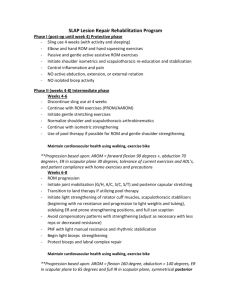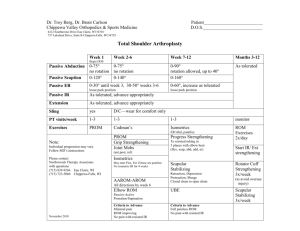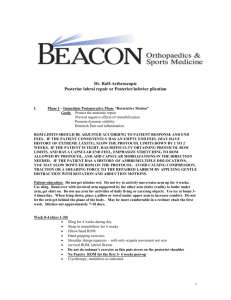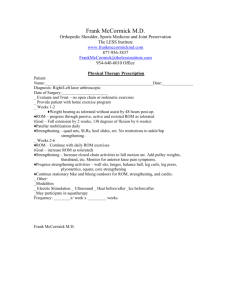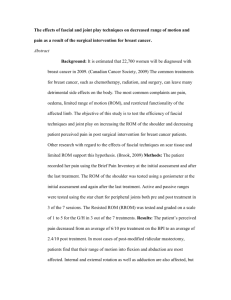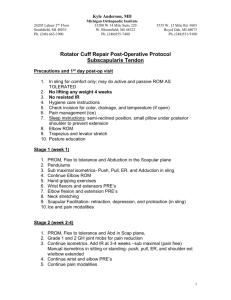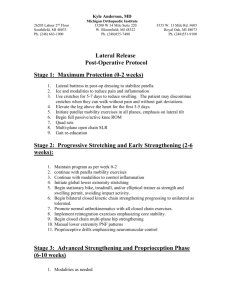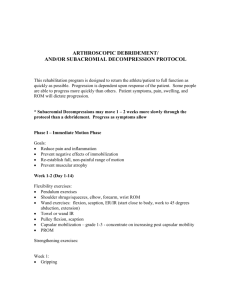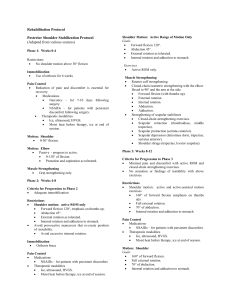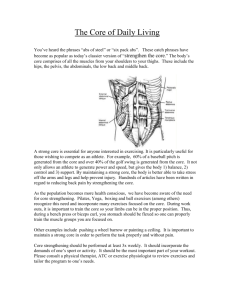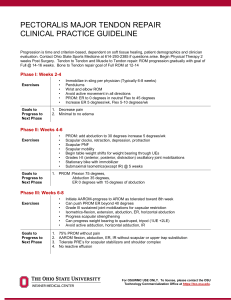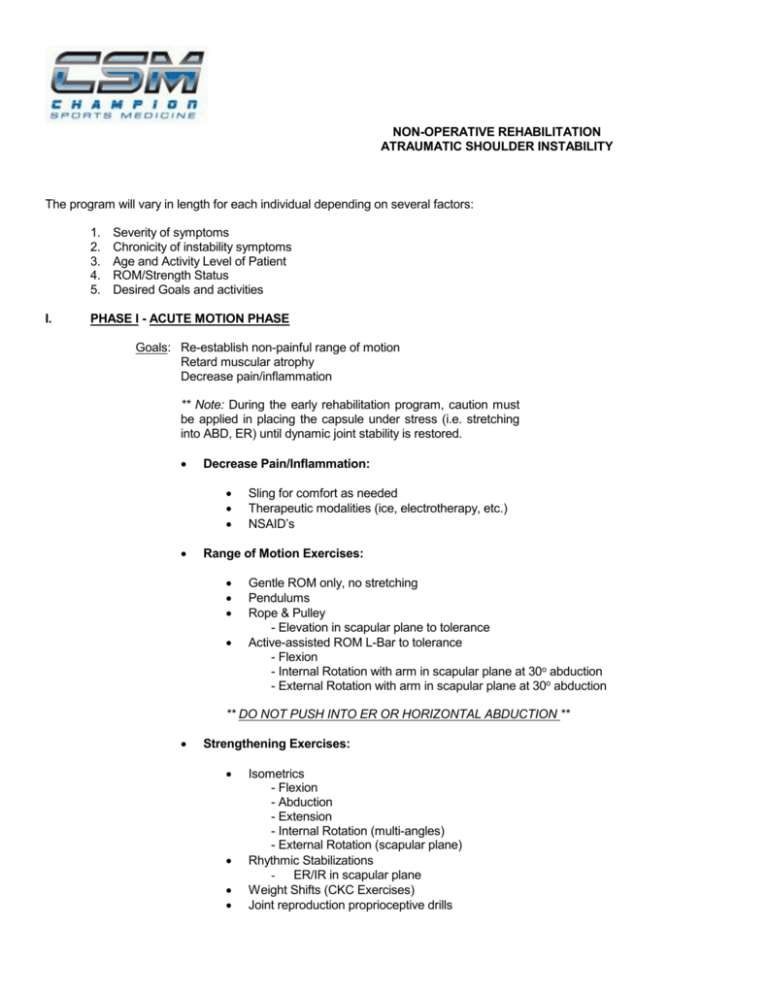
NON-OPERATIVE REHABILITATION
ATRAUMATIC SHOULDER INSTABILITY
The program will vary in length for each individual depending on several factors:
1.
2.
3.
4.
5.
I.
Severity of symptoms
Chronicity of instability symptoms
Age and Activity Level of Patient
ROM/Strength Status
Desired Goals and activities
PHASE I - ACUTE MOTION PHASE
Goals: Re-establish non-painful range of motion
Retard muscular atrophy
Decrease pain/inflammation
** Note: During the early rehabilitation program, caution must
be applied in placing the capsule under stress (i.e. stretching
into ABD, ER) until dynamic joint stability is restored.
Decrease Pain/Inflammation:
Sling for comfort as needed
Therapeutic modalities (ice, electrotherapy, etc.)
NSAID’s
Range of Motion Exercises:
Gentle ROM only, no stretching
Pendulums
Rope & Pulley
- Elevation in scapular plane to tolerance
Active-assisted ROM L-Bar to tolerance
- Flexion
- Internal Rotation with arm in scapular plane at 30o abduction
- External Rotation with arm in scapular plane at 30o abduction
** DO NOT PUSH INTO ER OR HORIZONTAL ABDUCTION **
Strengthening Exercises:
Isometrics
- Flexion
- Abduction
- Extension
- Internal Rotation (multi-angles)
- External Rotation (scapular plane)
Rhythmic Stabilizations
- ER/IR in scapular plane
Weight Shifts (CKC Exercises)
Joint reproduction proprioceptive drills
KW/JA 4/07
ATRAUMATIC-INSTABILITY - Page 2
II.
PHASE II - INTERMEDIATE PHASE
Goals: Regain and improve muscular strength
Normalize arthrokinematics
Improve neuromuscular control of shoulder complex
Criteria to Progress to Phase II:
1. Full Passive ROM (except ER)
2. Minimal Pain or Tenderness
3. “Good” MMT of IR, ER, Flexion, and Abduction
4. Baseline proprioception and dynamic stability
Initiate Isotonic Strengthening
Emphasis on External Rotation and Scapular Strengthening
- ER/IR Tubing
- Scaption with ER (Full Can)
- Abduction to 90 degrees
- Side lying external rotation to 45 degrees
- Shoulder shrugs
- Prone Extension to Neutral
- Prone Horizontal Adduction
- Prone Rowing
- Biceps
- Table Push-ups
- Triceps
Improve Neuromuscular control of Shoulder Complex
- Initiation of proprioceptive neuromuscular facilitation
- Rhythmic stabilization drills
- ER/IR at 90 degrees abduction
- Flexion/Extension/Horizontal at 100o Flexion, 20o horizontal abduction
- Progress CKC exercises with rhythmic stabilizations
- Wall stabilization on ball
- Static holds in push-up position on ball
- Push-ups on tilt board
Continue Use of Modalities (as needed)
- Ice, electrotherapy modalities
III.
PHASE III - ADVANCED STRENGTHENING PHASE
Goals: Improve strength/power/endurance
Improve neuromuscular control
Enhance dynamic stabilizations
Prepare patient/athlete for activity
Criteria to Progress to Phase III:
1. Full non-painful range of motion
2. No palpable tenderness
3. Continued progression of resistive exercises
Continue use of modalities (as needed)
Continue isotonic strengthening (PRE’s)
- Continue all exercises listed above
- Progress to end range stabilization
- Progress to full ROM strengthening
- Progress to bench press in restricted ROM
- Program to seated rowing and lat pull down in restricted ROM
Emphasize PNF
ATRAUMATIC-INSTABILITY - Page 3
PHASE III - Continued:
Neuromuscular control drills (for athletes)
- Ball flips on table
- End range RS with tubing
- Wall stabilizations on ball
- Push-ups on ball with rhythmic stabilizations
Initiate plyometric training
- 2-hand drills:
- Chest pass
- Side to side
- Overhead
- Progress to 1-hand drills:
- 90/90 throws
- Wall dribbles
** PRECAUTION IS AVOIDING EXCESSIVE STRESS ON CAPSULE **
IV.
PHASE IV - RETURN TO ACTIVITY PHASE
Goals: Maintain optimal level of strength/power/endurance
Progressively increase activity level to prepare patient/athlete for full functional return to activity/sport
Criteria to Progress to Phase IV:
1. Full ROM
2. No pain or palpable tenderness
3. Satisfactory isokinetic test
4. Satisfactory clinical exam
Continue all exercises as in Phase III
Initiate Interval Sport Program
Continue Modalities (as needed)
FOLLOW-UP
Isokinetic Test
Progress Interval Program
Maintenance of Exercise Program
Copyright © 2004 by the Advanced Continuing Education Institute, LLC. All Rights Reserved. Any redistribution or
reproduction of any materials herein is strictly prohibited.


